
The Samsung GT-I7500 Galaxy is a smartphone manufactured by Samsung that uses the open source Android operating system. It was announced on 27 April 2009 and was released on 29 June 2009 as the first Android-powered device from Samsung Mobile, and the first in what would become the long-running Galaxy series. It is succeeded by the Samsung Galaxy S.

The Sony Ericsson Xperia X10 is a 2010 high end smartphone in the Xperia series designed by Sony Ericsson. It was the first Sony Ericsson smartphone to run the Android operating system. The phone was shipped with Android 1.6 (Donut), but an upgrade to 2.1 (Eclair) was made available starting 31 October 2010, with a gradual international rollout. Originally, Sony Ericsson stated that the X10 would not receive an upgrade to Android 2.2 (Froyo) or beyond, but the phone was later upgraded to 2.3.3 (Gingerbread) with the updates starting on 29 July 2011.
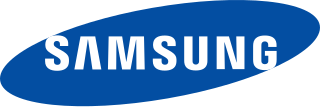
The Samsung Wave is a smartphone developed and produced by Samsung Electronics. It is the first smartphone to run the Bada operating system developed by Samsung Electronics, which was commercially released on May 24, 2010. The Wave is a touchscreen phone powered by Samsung's "Hummingbird" CPU (S5PC110), which includes 1 GHz ARM Cortex-A8 CPU and a built-in PowerVR SGX 540 graphics engine. It also has a "Super AMOLED" screen and 720p high-definition video capture capabilities. Due to shortage of Super AMOLED screens, Samsung released a successor to the device called Wave II and ceased production of the original S8500 model.

The Samsung Galaxy S is a touchscreen-enabled, slate-format Android smartphone designed, developed, and marketed by Samsung Electronics; it is the first smartphone of the Samsung Galaxy S series. It is the first device of the third Android smartphone series produced by Samsung. It was announced to the press in March 2010 and released for sale in June 2010. Due to shortage of Super AMOLED displays, Samsung released a successor to the device called S scLCD or SL and ceased production of the original I9000 model.

The HTC Aria is a smartphone manufactured by HTC Corporation that runs the Android operating system with HTC Sense.
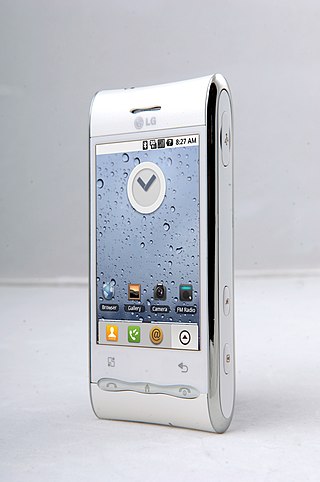
The LG Optimus, also known as the LG Optimus GT540, LG GT540 Swift and the LG Loop GT540, is a mid-level Android smartphone designed and manufactured by LG Electronics. Released running Android 1.6 Donut, the device can be officially upgraded to Android 2.1 Eclair via an LG software release.

The ZTE Blade V880 is a smartphone manufactured by ZTE Corporation for the Android platform. Unveiled by Orange UK as San Francisco, it went on sale on 21 September 2010, with a white variant released later. By 2011, more than 8 million Blade handsets have been sold in more than 50 countries worldwide.

The Samsung Galaxy 5,, is a smartphone. It uses the open source Android operating system (OS). It was announced on June 15, 2010.

The Nexus S 4G is a smartphone co-developed by Google and Samsung and manufactured by Samsung Electronics for release in 2010. It was the first smartphone to use the Android 2.3 "Gingerbread" operating system, and the first Android device to support Near Field Communication (NFC) in both hardware and software.

The Samsung Infuse 4G it was an Android smartphone that was released by Samsung in May 2011. It has a 1.2 GHz Hummingbird processor with 8–16 GB internal Flash memory, a 4.5 inch 480×800 pixel Super AMOLED Plus capacitive touchscreen display, an 8-megapixel camera and a 1.3-megapixel front-facing camera.
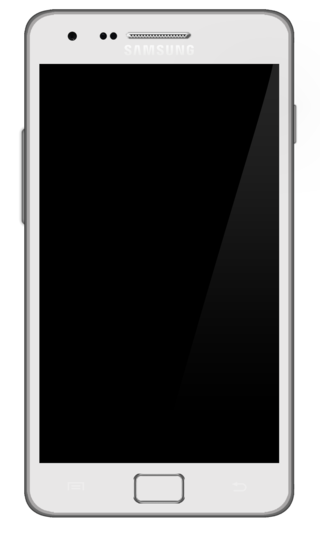
The Samsung Galaxy S II is a touchscreen-enabled, slate-format Android smartphone designed, developed, and marketed by Samsung Electronics, as the second smartphone of the Samsung Galaxy S series. It has additional software features, expanded hardware, and a redesigned physique compared to its predecessor, the Samsung Galaxy S. The S II was launched with Android 2.3.4 "Gingerbread", with updates to Android 4.1.2 "Jelly Bean".
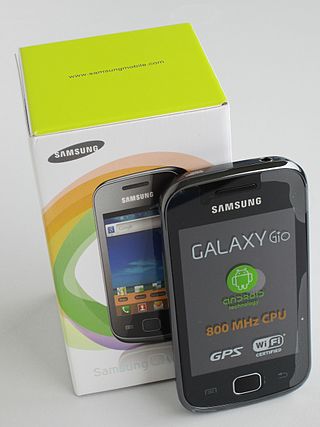
Samsung Galaxy Gio (GT-S5660) is a smartphone manufactured by Samsung and running the Android operating system.
The Samsung Galaxy R (Royal) (GT-I9103) is an Android smartphone that was announced by Samsung on August 10, 2011 as a variant to the Samsung Galaxy S II.
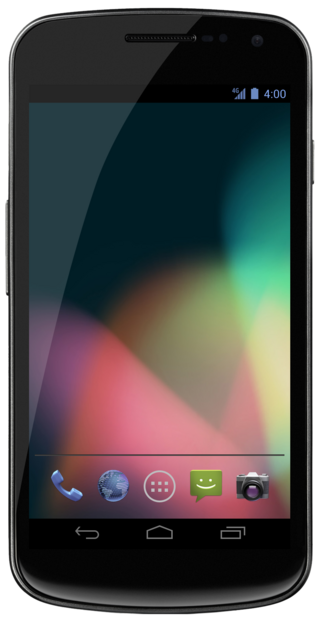
The Galaxy Nexus (GT-I9250) is a touchscreen Android smartphone co-developed by Google and Samsung Electronics. It is the third smartphone in the Google Nexus series, a family of Android consumer devices built by an original equipment manufacturer partner. The phone is the successor to Google's previous flagship phones, the Nexus One and Nexus S.

The Samsung Captivate Glide (SGH-i927) as it is called in the United States, and sold as the Samsung Galaxy S Glide (SGH-i927R) in Canada, is the first physical QWERTY Galaxy S class smartphone running under the Android operating system to be released by Samsung for AT&T (US) and Rogers Wireless (Canada).
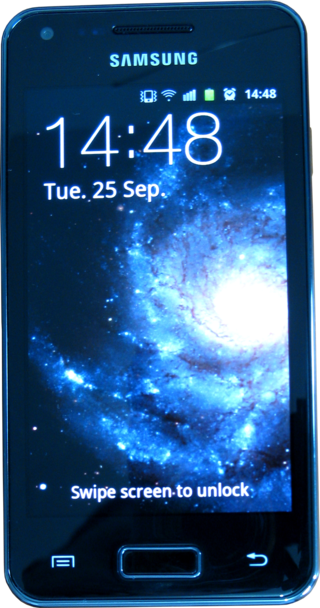
The Samsung GT-I9070 Galaxy S Advance is an Android smartphone manufactured by Samsung Electronics. It was announced on 30 January 2012 and released in April 2012 as an "advanced" variant to the original Galaxy S.

The Samsung Galaxy S Plus or Samsung Galaxy S 2011 Edition is an Android smartphone, introduced July 2011.
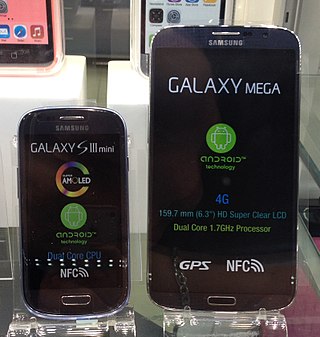
The Samsung Galaxy Mega is an Android-based phablet that was manufactured and released by Samsung. It was announced on April 11, 2013. The original model featured a 6.3 in (160 mm) screen, though a revised version was released with a 5.8 in (150 mm) screen. It has a 1,280×720 screen, a dual-core 1.7 GHz processor and an 8-megapixel camera. The phone runs Android 4.2.2 "Jelly Bean" software, and internal storage is 8 or 16 GB.
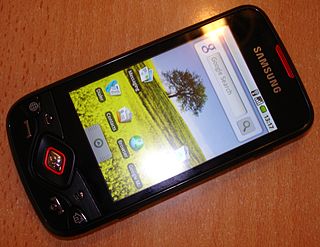
The Samsung Galaxy Spica, also known as Samsung Spica, Samsung GT-I5700, Samsung Galaxy Lite and Samsung Galaxy Portal, is a smartphone manufactured by Samsung that uses the open source Android operating system. The phone is positioned below the Samsung Galaxy (original). Even though some of its features like the camera resolution, storage and data connection speeds are lower than the i7500 its processor's clock speed is much higher at 800 MHz. It is succeeded by the Samsung Galaxy 3.
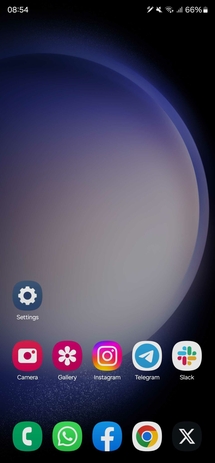
One UI is a user interface developed by Samsung Electronics for its Android devices running Android 9 "Pie" and later. Succeeding Samsung Experience and TouchWiz, it is designed to make using larger smartphones easier and be more visually appealing. To provide more clarity, some elements of the UI are tweaked to match colors that are based on the color of the user's phone. It was announced at Samsung's developer conference in 2018, and was unveiled in Galaxy Unpacked in February 2019 alongside the Galaxy S10 series, Galaxy Buds and the Galaxy Fold.



















